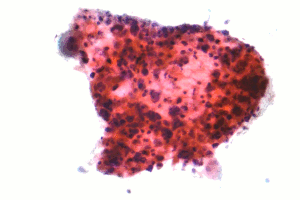Non-small cell lung carcinoma
| Non-small-cell lung carcinoma | |
|---|---|
 |
|
| Micrograph of a squamous carcinoma, a type of non-small-cell lung carcinoma. FNA specimen. Pap stain. | |
| Classification and external resources | |
| ICD-10 | C34.90 |
| ICD-9-CM | 162 |
| MedlinePlus | 007194 |
| eMedicine | med/1333 |
| MeSH | D002289 |
Non-small-cell lung carcinoma (NSCLC) is any type of epithelial lung cancer other than small cell lung carcinoma (SCLC). NSCLC accounts for about 85% of all lung cancers. As a class, NSCLCs are relatively insensitive to chemotherapy, compared to small cell carcinoma. When possible, they are primarily treated by surgical resection with curative intent, although chemotherapy is increasingly being used both pre-operatively (neoadjuvant chemotherapy) and post-operatively (adjuvant chemotherapy).
The most common types of NSCLC are squamous cell carcinoma, large cell carcinoma, and adenocarcinoma, but there are several other types that occur less frequently, and all types can occur in unusual histologic variants and as mixed cell-type combinations. Non-squamous cell carcinoma almost occupy the half of NSCLC. In the tissue classification, the centural type contains about one-ninth.
Sometimes the phrase "not otherwise specified", or NOS is used generically, usually when a more specific diagnosis cannot be made. This is most often the case when a pathologist examines a small amount of malignant cells or tissue in a cytology or biopsy specimen.
Lung cancer in never-smokers is almost universally NSCLC, with a sizeable majority being adenocarcinoma.
On relatively rare occasions, malignant lung tumors are found to contain components of both SCLC and NSCLC. In these cases, the tumors should be classified as combined small cell lung carcinoma (c-SCLC), and are (usually) treated like "pure" SCLC.
Adenocarcinoma of the lung is currently the most common type of lung cancer in "never smokers" (lifelong non-smokers). Adenocarcinomas account for approximately 40% of lung cancers. Historically, adenocarcinoma was more often seen peripherally in the lungs than small cell lung cancer and squamous cell lung cancer, both of which tended to be more often centrally located. However, recent studies suggest that the "ratio of centrally-to-peripherally occurring" lesions may be converging toward unity for both adenocarcinoma and squamous cell carcinoma.
...
Wikipedia
